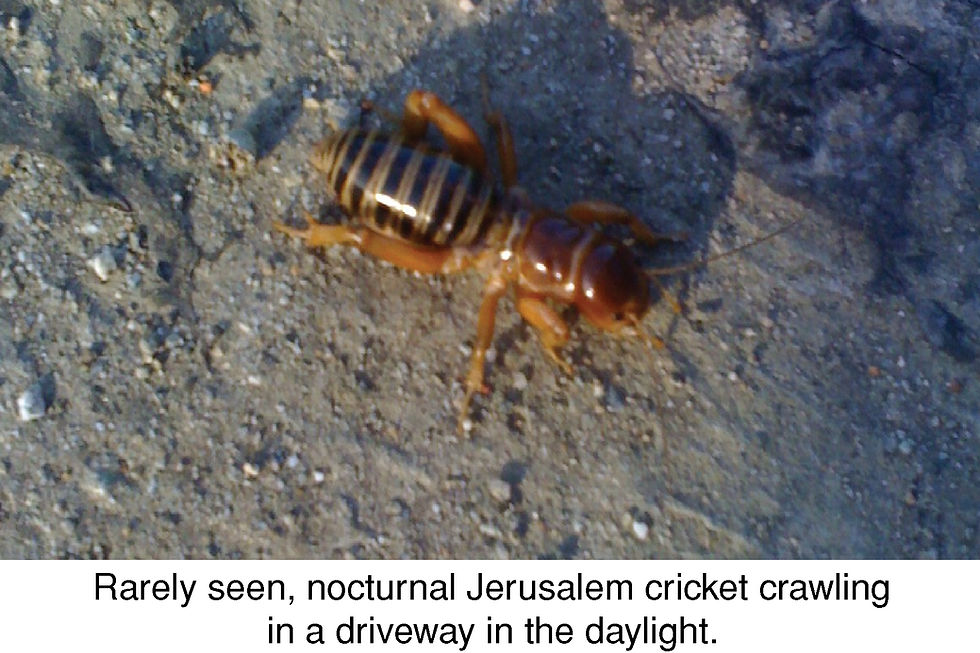THE BUG MAN: The Formidable, and Misnamed, Potato Bug
- Rachel Cobb

- Jul 7, 2019
- 3 min read

By James A. Bethke.
This is the first in a series of articles about the insect creatures in our gardens from entomologist James Bethke, well-known for his appreciation of the bugs that share our landscape.
As a young entomologist, one of the most fascinating and formidable insects that I found when I moved to California was the potato bug, at least that’s what everybody called it. However, potato bugs are actually in an insect group of their own called Jerusalem crickets (Order: Orthoptera; Family: Stenopelmatidae). They are closely related to katydids or camel crickets, and they are not in the cricket Family: Gyrillidae. The Jerusalem crickets are native to the western United States and are found from the west coast to the Dakotas, Nebraska, Kansas, Oklahoma, and Texas. They are also found in parts of Mexico and Central America, but they are not found in Jerusalem or the Middle East as the name might suggest.
When digging around, as any entomologist would do, I’ve seen very small ones and very large ones (2½ to 3”). I’ve tried to pick them up by grabbing the back or thorax, but they use their very spiny legs to push up and poke my fingers. How rude. When bothered, they turn over and thrust their spiny legs at the offender. They also have very strong jaws. The spines, jaws and strength make it easy for them to dig tunnels in soil and find food. They are usually found under boards or rocks. One of my colleagues at UC Riverside did a little research on our local populations in the Palm Springs area. He would wet the sand, cover it with a piece of plywood, and return a week later to collect and count specimens to determine species and population dynamics.
Like most crickets, they come out at night and are rarely seen during the day, and again, like most crickets, they are food for a lot of other animals because they are full of proteins. They have been found in the droppings of owls, hawks, coyotes, foxes, bats, badgers, and skunks. They are omnivorous and use their strong mandibles to feed primarily on decaying plants, roots and tubers, but they have also been observed feeding on other insects and carrion. Despite being called potato bugs, potatoes are very rarely part of their diet, and they are not known as a pest insect.
Further, like most crickets, each species of Jerusalem cricket produces a different mating call. These insects beat their abdomen against the ground in a distinct drumming to attract a mate. Following mating, the female often has her mate for dinner, not over for dinner… for her dinner. Like other insects, Jerusalem crickets grow by shedding their skin and take about 1 ½ to two years to become an adult. Adults will live about 2-6 months during which mating occurs and females lay new clutches of eggs.
Jerusalem crickets have huge jaws and can inflict a nasty bite if you grab them; although I don’t know why you would. They are not venomous, but you will find some information on the Internet that claims they are or that their saliva carries some toxin. It is more likely that those that experienced a bite had secondary infections from poor or no treatment. When provoked, the crickets can produce a foul odor like a stink beetle or earwig.
I’ve heard friends tell me that the cricket was chasing them across the patio. I always chuckle and make them mad. They can’t run, jump or attack you at all, and probably can’t even see you. All they want to do is get out of the light and back into the soil. Instead, the next time you see one, I hope you take the time to observe how fascinating this cricket really is.
Jim Bethke worked for UC Cooperative Extension as the Floriculture and Nursery Advisor in San Diego County. He is now retired and still conducts research and education as an emeritus advisor. He has a passion for the insect world and shares that passion on the Internet.
